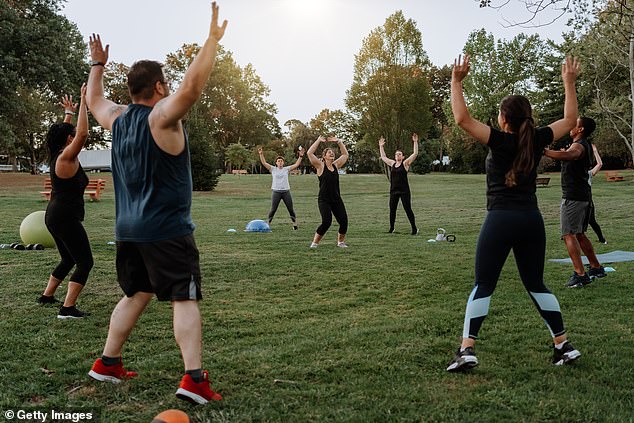-
EXPLORE FURTHER: The frequency of exercise needed to combat over 200 illnesses
Exercising only two days each week might be sufficient to ward off cancer and heart disease, according to a new study.
Scientists from around the world discovered that engaging in at least 150 minutes of moderate to intense physical activity can be beneficial.
engaging in physical exercise across two days
provided comparable health advantages to exercising throughout the whole week.
Individuals who engaged in physical activity solely on two days exhibited a 32 percent reduced likelihood of succumbing to any cause of death, a 31 percent decreased probability of passing away due to cardiovascular diseases, and a 21 percent lowered risk of mortality resulting from cancer.
The American Heart Association suggests that adults should get approximately 150 minutes of moderate aerobic exercise each week, or around 75 minutes of intense aerobic activity weekly, with options to mix both as long as it is distributed evenly over the week.
Nevertheless, this research indicates that 150 minutes of activity can be equally effective when completed over merely two days.
Dr. Zhi-Hao Li, an epidemiologist working at Southern Medical University in Guangzhou,
China
The study’s corresponding author remarked: “Daily workouts aren’t necessary for maintaining good health.”
‘So long as you accumulate at least 150 minutes of moderate to intense physical activity each week — whether this is condensed into one or two days or distributed evenly — you can substantially lower your chances of succumbing to heart-related diseases.’
cancer
or other causes.’

The study, published in the Journal of the American Heart Association, divided nearly 100,000 people from the UK 37 to 73 years old into three groups.
The categories consisted of ‘active weekend warriors,’ individuals who performed most of their physical activities in one or two days; ‘active regulars,’ those who distributed their workouts evenly across the week; and finally, ‘inactives,’ which referred to participants failing to achieve 150 minutes of weekly activity.
The researchers subsequently examined seven days of physical activity data recorded by an accelerometer—a tool designed to measure motion—as well as related health metrics gathered between 2013 and 2015.
The sensors recorded various actions like walking, running, indoor cycling, using an elliptical machine, doing housework, tending to the garden, and enjoying recreational pursuits such as dancing.
According to the information provided, more than 42 percent of participants fell into the category of weekend warriors, approximately 24 percent were deemed active regulars, and almost 34 percent were consideredinactive.
The gathered information was subsequently assessed to determine how various physical activity patterns could influence the likelihood of mortality from all causes, heart-related conditions, and cancers.
The risk associated with each condition was determined utilizing the International Classification of Diseases, Tenth Revision — a worldwide standard for coding the reasons for deaths.
When compared to those who were inactive, individuals in both the weekend warrior and active regular categories experienced a notably reduced chance of dying from various causes, including heart diseases and cancers, provided they engaged in at least 150 minutes of exercise each week—whether this activity was condensed into one or two days or spread out across the entire week.
In the active regular group, the overall risk of dying from any cause was reduced by 26 percent; the risk of mortality due to cardiovascular diseases dropped by 24 percent, and the likelihood of succumbing to cancer decreased by 13 percent.
According to Dr. Li’s conclusion, he stated: “This finding is positive news for individuals with hectic schedules who find it challenging to incorporate regular exercise into their routine but can manage to engage in intense physical activities during weekends or over a few consecutive days.”
The study offers comforting proof that even occasional exercise can yield long-term health advantages, simplifying efforts for individuals to focus on their wellness despite hectic routines.

Exercising even twice a week can help strengthen the heart muscles, which improves their ability to pump blood efficiently and thus, lowers the possibility of developing high blood pressure and high cholesterol levels.
It can also prevent the body from developing type 2 diabetes, mental health conditions such as anxiety and depression, arthritis and cancers including kidney, lung and stomach.
Nevertheless, even though weekend workout sessions show encouraging outcomes, it’s crucial to remain aware of possible injury hazards, particularly if you haven’t been physically active throughout the weekdays.
Dr. Keith Diaz, a physiologist from Columbia University who did not participate in the research, cautions that weekend warriors might have a minor increased risk of musculoskeletal injuries and should take precautions to avoid harm.
In the agency’s statement, he clarified: “A key point to keep in mind is that cramming 150 minutes of physical activity into only one or two days might put considerable strain on your body.”
Some studies indicate that individuals who engage in physical activity only during weekends might face a somewhat elevated chance of experiencing musculoskeletal injuries when contrasted with people who work out more consistently throughout the week.
Yet, the advantages of working out solely during weekends significantly surpass the possible dangers. Should you choose to become a weekend warrior, ensure you perform adequate warm-up routines and gradually increase your activity levels over time.
‘This will aid in minimizing your chance of getting injured.’
Read more

